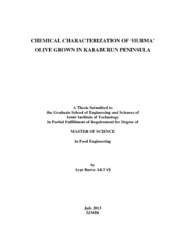Please use this identifier to cite or link to this item:
https://hdl.handle.net/11147/3581Full metadata record
| DC Field | Value | Language |
|---|---|---|
| dc.contributor.advisor | Özen, Fatma Banu | en |
| dc.contributor.author | Aktaş, Ayşe Burcu | - |
| dc.date.accessioned | 2014-07-22T13:51:51Z | - |
| dc.date.available | 2014-07-22T13:51:51Z | - |
| dc.date.issued | 2013 | en |
| dc.identifier.uri | http://hdl.handle.net/11147/3581 | - |
| dc.description | Thesis (Master)--Izmir Institute of Technology, Food Engineering, Izmir, 2013 | en |
| dc.description | Includes bibliographical references (leaves: 86-91) | en |
| dc.description | Text in English; Abstract: Turkish and English | en |
| dc.description | xiii, 95 leaves | en |
| dc.description.abstract | Olive type, mostly Erkence, grown in nearby area around Karaburun peninsula of Izmir-Turkey, goes through a natural debittering phase on the tree during its ripening. This olive is known by the name of Hurma and loses its bitter taste while still on the tree and can be consumed directly at the end of this natural process. The aim of this study is to investigate the changes in the chemical composition of Hurma, Erkence and Gemlik olives throughout their maturation period and to determine some chemical compositional differences between Hurma and other types of olives to obtain more insight about the natural debittering phenomena. For this purpose, the chemical parameters measured are pH, water activity, total fat amount, fatty acids, sugar and organic acid amounts, total phenol content and phenol profile. All analyses were performed for two harvest years. Data were analyzed by ANOVA and principal component analysis (PCA) to investigate the differences regarding the olive types, ripening period and harvest year. Total phenol content and generally concentration of individual phenolic compounds of Hurma olive were lower than Erkence and Gemlik olives. Both fatty acid and phenol profiles allowed a differentiation with respect to type and also harvest year according to PCA while organic acid and sugars provided a separation only in terms of harvest year. | en |
| dc.language.iso | en | en_US |
| dc.publisher | Izmir Institute of Technology | en |
| dc.rights | info:eu-repo/semantics/openAccess | en_US |
| dc.subject.lcsh | Olive--Analysis | en |
| dc.title | Chemical characterization of 'hurma' olive grown in Karaburun Peninsula | en_US |
| dc.type | Master Thesis | en_US |
| dc.institutionauthor | Aktaş, Ayşe Burcu | - |
| dc.department | Thesis (Master)--İzmir Institute of Technology, Food Engineering | en_US |
| dc.relation.publicationcategory | Tez | en_US |
| item.fulltext | With Fulltext | - |
| item.grantfulltext | open | - |
| item.languageiso639-1 | en | - |
| item.openairecristype | http://purl.org/coar/resource_type/c_18cf | - |
| item.cerifentitytype | Publications | - |
| item.openairetype | Master Thesis | - |
| Appears in Collections: | Master Degree / Yüksek Lisans Tezleri | |
Files in This Item:
| File | Description | Size | Format | |
|---|---|---|---|---|
| 10006394.pdf | MasterThesis | 2.06 MB | Adobe PDF |  View/Open |
CORE Recommender
Page view(s)
272
checked on Nov 18, 2024
Download(s)
132
checked on Nov 18, 2024
Google ScholarTM
Check
Items in GCRIS Repository are protected by copyright, with all rights reserved, unless otherwise indicated.